Armament Research Services (ARES) has a database of Conflict Material (CONMAT), logging arms and munitions documented within the illicit sphere in conflict and post-conflict zones. I have been working on co-athoring a report with N.R. Jenzen-Jones covering Libyan arms trading conducted via social media platforms between November 2014 and November 2015 for Small Arms Survey. One of the interesting side benefits of digging through a database of thousands of documented arms is finding some particularly old items that have been wandering the planet for 50 or 100 years.
For example, this Italian M91 Carcano cavalry carbine. It could have been lost during the North African campaigns of WWII, or could have come into the country at some other time thanks to Italy’s colonial influence in Libya. It’s chambered in 6.5mm (we can tell this from the rear sight configuration), and it actually not a bad little gun, contrary to its reputation (although this one has definitely seen better days).
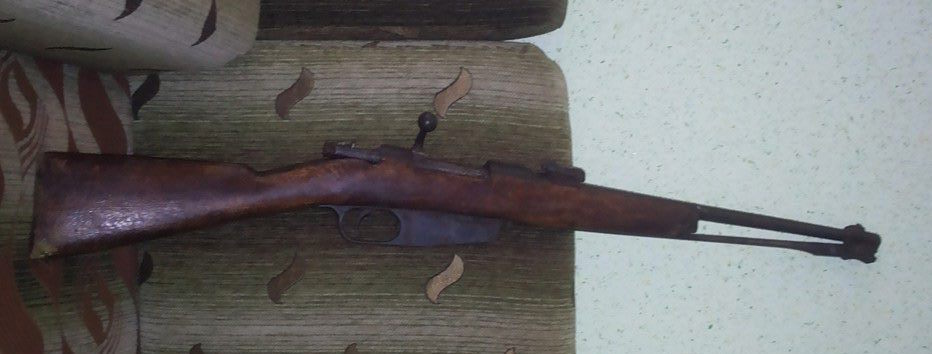
Here’s another view – the folding spike is a bayonet (affixed to the gun to simplify a mounted cavalry trooper’s ability to use it). The photographer appears to not realize that purpose, though, and seems to to be suggesting its use as an ad-hoc monopod.
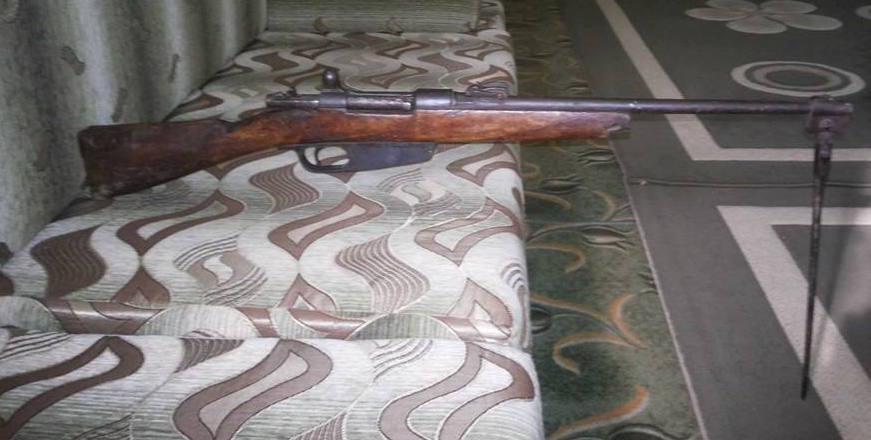
Here’s another bolt action rifle documented in Libya; a No4 Lee Enfield. It’s missing its magazine, but it most likely chambered for .303 British. Again, could have been lost during WWII or come into the country through any of a bunch of other routes.
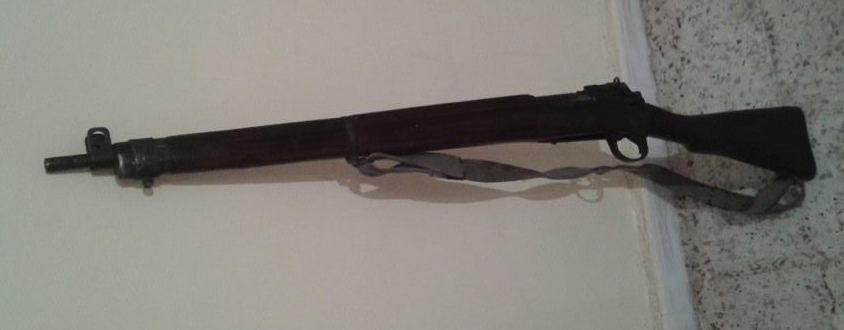
It’s not just obsolete rifles that make an occasional showing, but also handguns. For example, Webley revolvers – both military and commercial pattern. Here is one of the Mk IV .38/200 caliber examples documented in the ARES database:
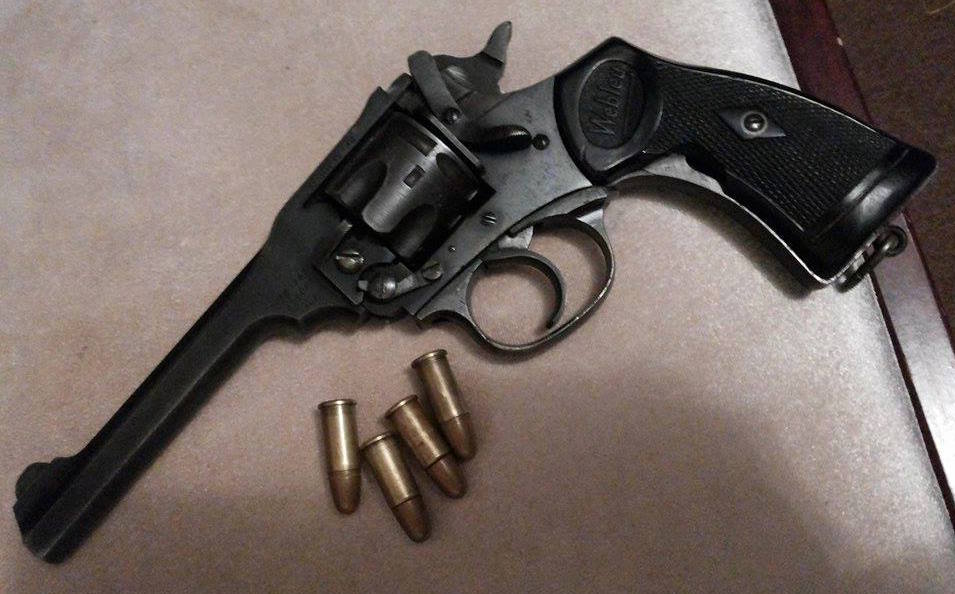
And here’s a smaller commercial pocket model (also a Mk IV, somewhat confusingly):
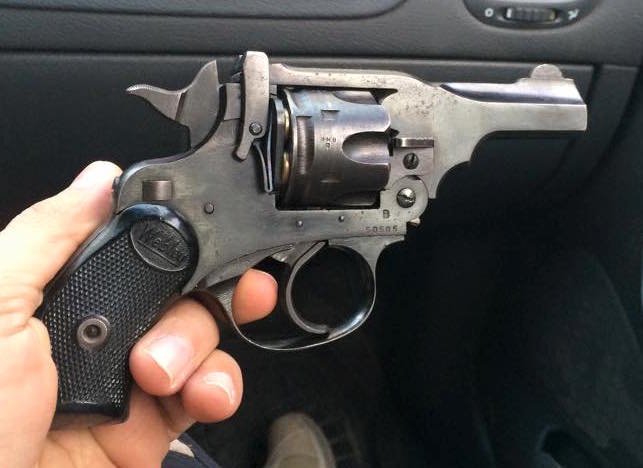
In some cases, the guns that do not show up in the database are as interesting as the ones that do. For example, the Mosin Nagant is curiously absent, although there are many documented examples of DP-27, PK/PKM, Dragunov, and PSL. The ammunition is not lacking, and we have seen Mosins in other regional conflict zones – but they seem to be absent in Libya.
If you are interested in the subject, you will definitely enjoy reading the full report when it is published in a few months. Stay tuned!


I have a MK4 .38 Webley. It is a truly nice pistol to shoot.
Very interesting! Keep up the good work.
Libyan rebels who had their own hunting weapons (world war relics) tended not to trade them for more modern weaponry, unless I’m totally wrong. Why relearn the shooting process when the “better, modern” weapon has no ammo available? Unless you grab an ammunition stash to go with the assault rifle, that captured weapon will be nothing more than a useless club. Bolt action rifles, especially those missing magazines, are best used to pick off important officers (and if I’m not mistaken, the old regime had a nasty habit of giving said officers lots of flashy bling-bling style uniforms).
Did I mess up?
It’s a constant with Third world Ruritanian states that their military high-rankers all want to look more “military” than Napoleon. As such, they all end to end up dressing like Hermann Goering;
http://media-2.web.britannica.com/eb-media/13/11413-004-D9FFDA51.jpg
Unlike Goering of course, most of them never earned the decorations and have no idea what they’re for. But they’re generals, and they’re going to looklike generals, dammit!
Lots of medals, saluting, and wearing a Sam Browne belt are all “target indicators”, according to Maj. John Plaster. In fact, U.S. Army and Marine sharpshooters refer to the shoulder strap of a Sam Browne belt as the “Shoot Me Strap”.
cheers
eon
“But they’re generals, and they’re going to looklike generals, dammit!”
According to more bling-bling better commander, then Joachim Murat
https://en.wikipedia.org/wiki/File:François_Pascal_Simon_Gérard_005.jpg
should be one of best commanders in history
Similarly, Soviet generals eventually outdid the bling of German generals by getting Czarist uniforms out of the closets and replacing the insignias with communist symbols. The most decorated Soviet general I can think of, Georgy Zhukov, liked Coca-Cola to the point of asking Eisenhower if a decolored version could be smuggled into Russia in vodka bottles…
https://en.wikipedia.org/wiki/White_Coke
Interesting story about White Coke. I would also suggest we could also send him some great tasting Crystal Pepsi. I don’t know how many of you guys had the misfortune of trying that drink back in the day.
“Soviet generals eventually outdid the bling of German generals by getting Czarist uniforms out of the closets and replacing the insignias with communist symbols.”
Notice that ribbon bars were virtually unknown to Soviet commanders
http://peashooter85.tumblr.com/post/125680533608/soviet-admiral-s-g-gorshkov
so they might look to have more badges even if they haven’t
I have come to the conclusion that all the medals that Sovet generals wore were a form of body armor.
Then Leonid Brezhnev:
https://en.wikipedia.org/wiki/Awards_and_decorations_received_by_Leonid_Brezhnev
should be indestructible, people joked that:
”
-Can u guess two soviet badges NOT awarded to Brezhnev?
-…
-Hero City and Mother Heroine
“
Hermann Göring earned his medals? What about the “Grand Cross of the Iron Cross” that was soley invented and only awarded to Göring? The medals during WW1 were really earned. The medals that Göring earned during the nazi-regime where just vanity awards…
My point exactly. People forget that before he was the Bling King of Nazi Germany, Goering was the highest-scoring surviving fighter ace the Germans had in the first go-round. He replaced von Richthofen as CO of the “Flying Circus” after v.R. was shot down.
With him, the problem was distinguishing the real awards (from the Imperial and even Weimar era) from the “made-up” ones from the Nazi years.
Nutty bugger, evil son-of-a-buck, but until he got too portly to get in a cockpit, one hardcore fighter jock.
(To defeat your enemy, you have to understand him, as Sun-Tzu observed.)
cheers
eon
Ernst Udet had 62 victories and survived WW1 making him the highest scoring surviving German ace. He committed suicide rather than get arrested by the gestapo in 1941, He was Germany’s quarter master general at the beginning of ww2
Actually herr Meier was not even close to the highest-scoring German WW1 ace who survived the war. That would have been Ernst Udet with 62 kills, the second-highest scoring German WW1 ace, who committed suicide in 1941. Even Göring’s eventual replacement and the last commander of the Luftwaffe, Robert Ritter von Greim, had more kills (28) than Göring (22).
“Hello, Herr Meier, how’s your hat?” Supposedly Goering had also said he’d eat his hat if the RAF ever bombed Germany…
“Actually herr Meier was not even close to the highest-scoring German WW1 ace who survived the war.”
Yes, see list of flying aces of Germany of WW1 here:
https://en.wikipedia.org/wiki/List_of_World_War_I_flying_aces_from_Germany
The less famous von Richtohofen – Lothar (brother of Manfred) scored 40 victories, died in air crash in 1922.
Udet’s suicide was not because he was going to be arrested. He had problems both in his personal and professional life. Göring didn’t listen to him and he though Göring was much too optimistic about the capabilities of the Luftwaffe, constantly bragging to Hitler about it. The basically technocrat position as the Generalluftzeugmeister (Luftwaffe Director-General of Equipment) was also not really to his liking, and Göring’s antics made the professional frustration much worse. He was (in retrospect) quite likely depressed and self-medicated with alcohol. The final suicide trigger was apparently that his girlfriend was about to leave him.
If all the African nations troops who wore paratrooper wings – big, like the French ones nicknamed “dog licenses” from the 70s on had ever even seen an airplane much less jumped out of one, ‘twould have seen a miracle indeed.
No doubt there is an armory somewhere in Libya that has a rack of old 11-mm Remington Rolling Blocks as well – those things just keep turning up. Seems like the last batch I saw on the surplus market had been used for a century as drill rifles at an Egyptian military-academy high school. I’ve also gotten the impression (probably here) that there are a surprising number of Stg-44 rifles floating around Libya as well.
Does the commercial short-barreled Webley have the thumb safety on the other side, or was that just the .32 police version?
During France’s effort to defeat the FLN insurgency in Algeria and retain it as an “overseas department” the FLN acquired numbers o Stg 44s. Many may have come from Jugoslavia, still others from the Soviet Bloc.
As an ex-Italian colony, there’d be rather a lot of Italian arms in Libya. Also, WWII what with the Afrika Korps und so weiter… Not that Rommel’s troops had StG44s in the desert.
Actually, most of the FLN’s MP44’s and other arms came from the Czechs. Yugoslavia exported Mausers and MG 42’s.
Also ex-German capture, French WW2 weapons like MAS 36, MAC 24/29, plus ex-Italian Carcanos and Breda 1930.
StGs and other good stuff was kept for us.
The .32 snub Webley has a lever type thumb safety on the top left grip frame. The MK IV 0.380in has a “crossbolt” type safety in the same place, a rectangular bar which, pushed all the way to the right, locks the hammer.
This requires a pair of grip panels that do not come all the way up the backstrap. The standard grip panels cover the holes for the safety. If you take the grips off of almost any MK IV .380, you’ll find the rectangular “ports” for that safety whether the revolver has it or not.
As for the .3 and 0.380in both being “MK IVs”, this is because the standard police service model and the pocket model were parallel development and production series, each with their own “MK” number sequence. There two just happened to each be the fourth variant in their respective “families”.
cheers
eon
“As for the .3 and 0.380in both being “MK IVs”, this is because the standard police service model and the pocket model were parallel development and production series, each with their own “MK” number sequence. There two just happened to each be the fourth variant in their respective “families”.”
So it is similar to American M1 rifle and M1 carbine (“first in rifle category” and “first in carbine category”)
BTW: Do you notice that during WW2 US used M3 Light Tank and M5 Light Tank, but not M4? Number 4 was omitted to avoid confusion with M4 Medium Tank (known as GENERAL SHERMAN)
Yep. And at one time the U.S. Army had no less than three M60s in service at the same time; a main battle tank with a rifled 105mm main gun, a 7.62 x 51 NATO GPMG… and an electric-powered submersible pump used for disaster-relief work. (It was very handy for pumping water out of flooded basements.)
Needless to say, you had to be careful with requisition forms.
cheers
eon
“no less than three M60s in service at the same time”
Probably most used designation was M1 during WW2, it can mean (incomplete list):
M1 Ball
M1 – rifle
M1 – carbine
M1 – 155mm howitzer
M1 – 240mm howitzer
M1 – 8-inch gun
M1 – 8-inch howitzer
M1 – 75mm pack howitzer
M1 – Light Tractor
M1 – Heavy Tractor
M1 – AA gun (37mm)
M1 – AA gun (40mm)
M1 – AA gun (90mm)
M1 – AA gun (120mm)
M1 – Ordnance QF 6-pdr
M1 – mortar (81mm)
M1 – Combat Car (actually light tank)
M1 – bulldozer blade (for M4 Sherman)
“Oh, just use one of those standard S-1798s and write in “pizza” where it says “machine gun.”
-Finally a context where that quote almost makes sense.
I’ve always gotten a kick out of noting that “P-38” also refers to an airplane, a can opener, and a German pistol. Loved Iggy’s quote; reminds me of a submarine-service shipmate (supply type) who swore he knew a Storekeeper on another boat who had transposed a couple of numbers in the Federal Stock Number on a requisition form and the Navy promptly delivered the left wing of an F-14 to the dock. They had a bitch of a time folding it so it would fit through the after hatch…….
Wonderful time Magazine photo late 70S showing a group of Ethiopian or Eritrean rebels waving a smorgasbord of weaponry. A lot of Carcanos, an MP44, either a Ljungmann or an Egyptian Hakim and an M-14 (?).
Ogaden War between Mengistu/Derg Ethiopia and Barré Somalia. The image is of Somalis.
Haile Selassie’s monarchy in Ethiopia received a lot of U.S. arms, including M14s. So too Haiti.
It appears that the smaller Webley is a detective model and is equipped with the Singapore safety.
The lack of Mosin-Nagants in Libya is explained by the 20th century history and geographic location of the country. The post-WW2 monarchy until 1969 was affiliated with the West and bought most of its weapons from the UK. The Gaddafi regime came late enough that Mosins were no longer sold or given by the Soviets to relatively rich countries like Libya. The country is also far enough from Soviet Union and the Middle East that Mosins didn’t find their way there otherwise.
That sounds about right. As Libya was an Italian colony from 1912, it is not surprising that old Italian rifles are to be found there, I saw several Carcanos on the news when Gadaffi was overthrown in 2011, as well as quite a few FALs, which I imagine date from King Idris’s time. Again, given that the 8th Army fought the Italian and DAK right across Libya, British weapons will be found there.
Much of Libyan society is tribal, and I rather expect that once weapons are in the hands of the tribe, they will not be given up lightly, even under a dictatorship such as Gadaffi’s.
Libya was a major battleground in WWII, and I remember reading that for several years after the war, the country’s main source of income was from selling scrap metal from all the tanks and other debris which littered the place.
One point; the Mannlicher-Carcano with the short barrel and folding “spike” bayonet is the Model 91 TS (for “Truppe Speziale”, “special troops”, meaning cavalry and artillery), and is properly referred to as a “moschetto” (“musketoon”), not a “carbine”.
The Italian Army did not adopt the term “carbine” until after 1943, I suspect because when they became the Italian Co-Belligerent Forces allied with us, they realized that nobody else knew what they were talking about, as every other army involved had dropped the term “musketoon” about seventy years earlier. (Even the French and Spanish.)
As for using the spike as a monopod, it has a latch that can hold it folded, extended, or pointed straight down for exactly that purpose. The idea was to aid in precise shooting at longer ranges; in fact, it tends to cause vertical stringing of groups due to upward pressure on the muzzle.
cheers
eon
eon; it would be much easier (less writing) as well as more historically correct to refer to the Italian Mod. 91 rifle and derivatives as Carcanos, not as “Mannlicher-Carcanos”… 😉
To add further to the naming business, in Italian Royal Army nomenclature a Sub-Machine Gun was “Moschetto Automatico”, which translates directly to “Automatic musketoon”, hence “MAB” = “Moschetto Automatico Beretta”, although the term “moschetto mitragliatore”, which translates to “Machine Musketoon” was also used. After WW2 “pistola mitragliatrice” (machine pistol), which originally referred only to full-auto pistols such as the Mauser M712 Schnellfeuer, replaced the earlier terms.
Fairly nice finish on the Webley’s, looking forward to leafing threw the full article.
My first time overseas to Mesopotamia (’04-’05), we found a ton of Enfield and Webley Revolvers. Ammo for them was scarce. The Iraqis in some cases had resorted to cutting down .357 Magnum Brass and reloading pulled bullets. We also came across a Remington 1911A1… No 45 ACP however.
Had I been a little wiser I would have packed my duffle bag full of Remington 38 S&W. They never inspected what was going into country…only what was coming back…